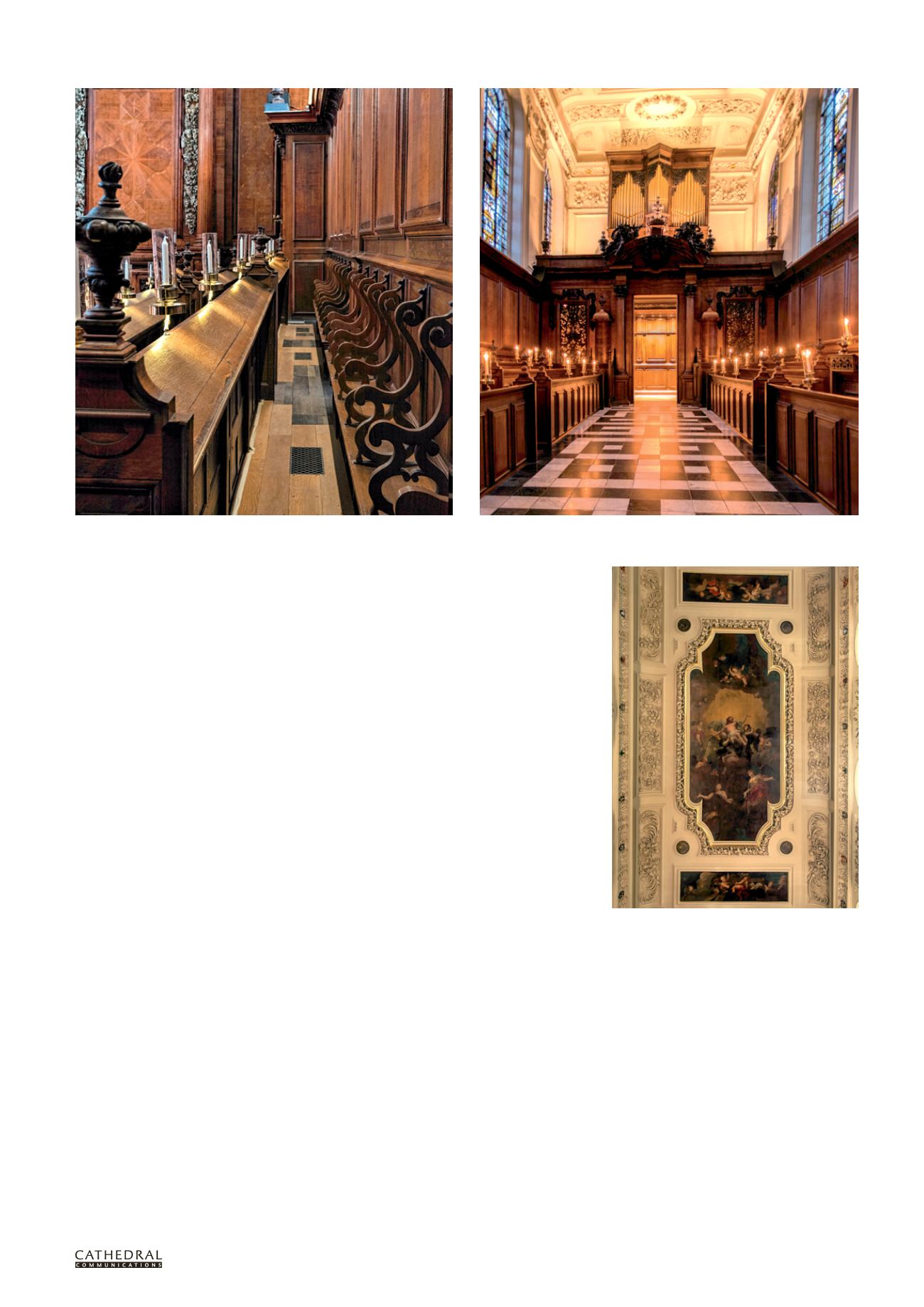

BCD SPECIAL REPORT ON
HISTORIC CHURCHES
24
TH ANNUAL EDITION
45
Repairs to the raised floor below the pews, with a mixture of new European oak
boards and sections of salvaged originals
The new lighting scheme: LED light pads beneath the candle holders provide
additional lighting during services.
Detail of the ceiling paintings and plasterwork after
cleaning and revarnishing
OTHER WORKS
The north and south walls are lined with
oak panelling as a backdrop to the fixed
stalls and pews facing towards the aisle.
These too had been over-waxed, stained
and polished. They were cleaned back to
remove the layers of wax and repaired at
the same time.
The supports to the raised floors
beneath the pews had deteriorated
over time and many were supported on
pieces of brick and timber. The main oak
bearers had disintegrated, mainly from
dampness and death watch beetle. The
floor structure was removed entirely then
carefully reconstructed, reusing original
material where possible.
The ceilings were carefully cleaned
and missing elements of plasterwork
were restored by Cliveden Conservation.
Because repairs to the ceiling paintings
had been so crudely executed in the
past, it was not realistically possible to
revert to the original paintwork. It was
therefore decided to clean the old varnish
off and re-varnish. A matt finish was
chosen because movement in the past
had resulted in an uneven surface, and the
reflections from the old glossier varnish
had been distracting. This has enabled a
better view of the paintings.
A new lighting scheme was essential
because the main light sources were 500W
halogen lamps which sat crudely above
the timber cornices and constituted a
fire hazard. Designed by church-lighting
specialist Mark Sutton Vane Associates,
the new scheme includes modern LED
lighting, much of which highlights
particular features and has transformed
the internal appearance of the chapel.
The stained glass windows were
carefully cleaned by the York Glaziers
Trust using small cotton wool swabs, and
the German window, which had been left
in an attic since the second world war,
was reinstated. Although the glass was
in good condition, the painted surfaces
of the coloured glass were felt to be too
fragile to expose to the elements. The
existing (plain) outer window, installed
after the window was removed in the
1940s, has therefore been retained to act
as a protective shield, with the restored
stained glass located inside it, with its
own sub-frame. This method of iso-
thermal glazing was developed by the
York Glaziers Trust and has been used by
them to similar effect in York Minster.
RE-OPENED AND RESPLENDENT
Following one of the most
comprehensive conservation and
cleaning programmes it has ever
undergone, the Grade I listed chapel
re-opened in April 2016. After a year’s
closure and a great deal of painstaking
work, it is once again resplendent.
Over 50 craftspeople were involved in
this major project, which is probably the
most significant and wide-ranging work
to be undertaken on the chapel since its
construction. The project has captured
the imagination of all of those who have
worked on it and their contributions
have widened our understanding of
Trinity’s best-known and most fascinating
building. The project has been honoured
by the local Oxford Preservation Trust
and commended by the Georgian Society.
MARTIN HALL
PGDipCons FRICS IHBC is
a director of Hall & Ensom Cotswolds Ltd,
Chartered Surveyors (www.hallandensom.
co.uk), where he specialises in advising clients
on the maintenance, conservation and
alteration of historic properties. He is an RICS
Certified Historic Building Professional.


















